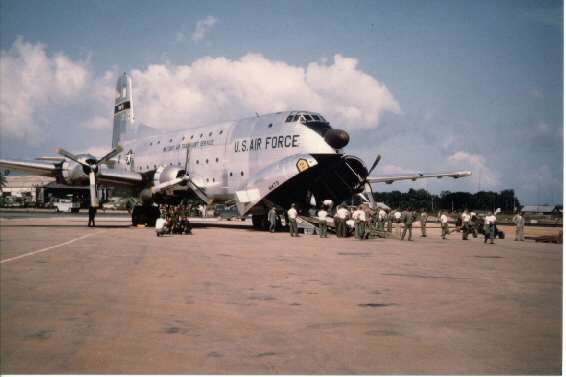
|
During the fist six months that
HMM-364 was in Vietnam (Jan. - Jun. '64), approximately 12 aircraft had
been destroyed and obtaining replacements was critical to providing support
for the Vietnamese Army. The fist solution was to have them sea lifted
by the WW II "jeep carriers" such as the USNS Cord or the USNS Breton,
which in late November 1963 had first brought HMM-364 to Southeast Asia.
Delivery by this form of transportation was 25 to 30 days. The second,
and mush preferred method, was to task the Air Force to deliver them with
the C-124 "Globemaster." A round trip with the C-124 from Travis
AFB, California to Vietnam and back took 97 flight hours. That was
tough on the Air Force crews but greatly appreciated by a Marine squadron
which was short of aircraft.

|
In 1964 the C-124 was the largest cargo aircraft the
Air Force had for the delivery of heavy and bulky items such as the UH-34D.
Flight engineers could crawl down the inside of the wings to service the
engines in flight. The cargo compartment was like a hangar.
Its statistics were:
| Wing Span 174' 1" | Length 130' | Height 48' 4" |
| Cruise Speed 230 mph | Range 4030 Miles | Ceiling 21,800 ft. |
| Crew of 8 | Cargo Capacity 93,000 lbs. | Passenger Capacity 200 |
| Placed in Service 1950 | Number Built 446 |
The C-124 was powered by 4 Pratt & Whitney R4360-63A
engines rated at 3,800 H.P. each. These were the largest piston driven
radial aircraft engines every built and used. They had 28 total cylinders
arranged in four banks of 7 cylinders each. To facilitate cooling,
they slightly offset the cylinders of each successive bank toward the rear.
This arrangement created a spiraling motion for the cooling air to get
from the front of the engine to the rear. However, after passing
over a total of 4 banks of cylinders the air became so hot that additional
banks of cylinders could not be cooled properly. At this point the
radial engine had been "maxed out"; larger aircraft had to wait for the
jet engine.
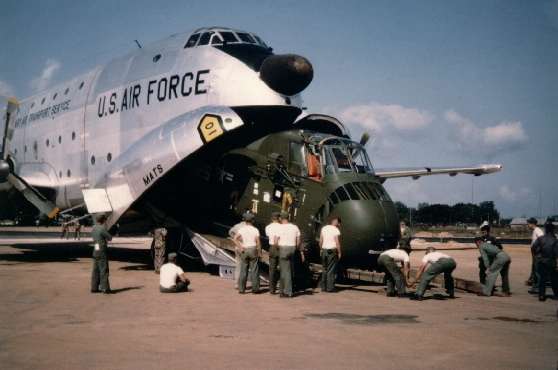
|
The UH-34D had been designed for carrier (and other amphibious ship) operations which allowed it to be "folded up" when not flying. The vertical section of the tail and its anti-torque tail rotor would fold 180 degrees back against the fuselage. The large diameter four bladed rotor system could also be folded back along the sides of the fuselage. These design factors allowed packing aircraft very close together aboard Navy ships but did not make them small enough to fit inside the C-124. To get the plane into the C-124 the height of the UH-34 had to be reduced as much as possible. Removing the tail section, rotor head and transmission helped but didn't get the job done. The main landing gear and struts were also removed from the plane and in their place a shaft with jeep wheels was substituted. This modification made the belly just clear the ground and allowed it to roll inside the C-124. The only problem was the ramp of the C-124 was so steep the nose would hit before the jeep wheels hit the runway. This was solved by making supplemental ramps that intercepted the C-124's ramp at a point just after the UH-34 cleared the nose of the C-124.
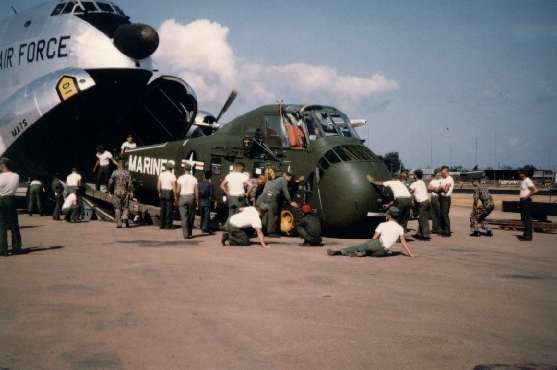
|
I think I can ID some of the people in the picture above. To the right of the picture is an individual in a camo flight suit crouching down - I think this is Lt. Michael D. Baker. To the left of him is Pfc. Lewis G. Presley, to the left of him is Pfc. Richard D. Wells. The individual on the right hand side of the nose of the plane is SSgt. Ervin S. Malea and next to him is SSgt. John C. Thompson. Reclining in front of the chopper is LCpl. Ralph W. Fournet. I think the individual in the flight suit and orange squadron hat , by the side cargo door of the chopper is Lt. Charles R. Upshaw. The individual in the flight suit walking toward the tail of the aircraft is GySgt. Robert D. Shane. The individual in the white T-Shirt behind the tail looking forward is SSgt. Donald C. Gale.
Below is the tail section, with its 4 anti-torque rotor
blades removed, being lowered from the belly of the C-124. The Marine
to the right and behind the tail section is Sgt. James Perkins.
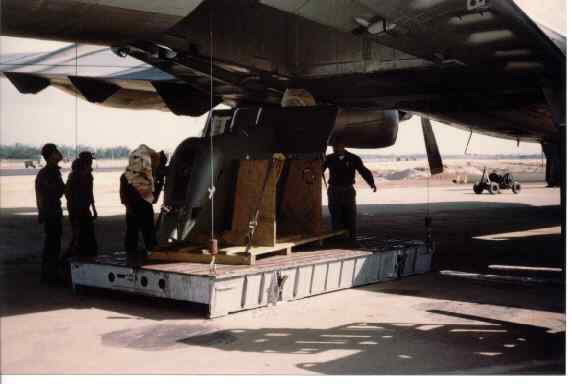
|
Once all the parts were outside, to include the rotor
head and transmission pictured below, it went together pretty fast
and easy. All the mechanics and shop personnel helped to complete
the task.
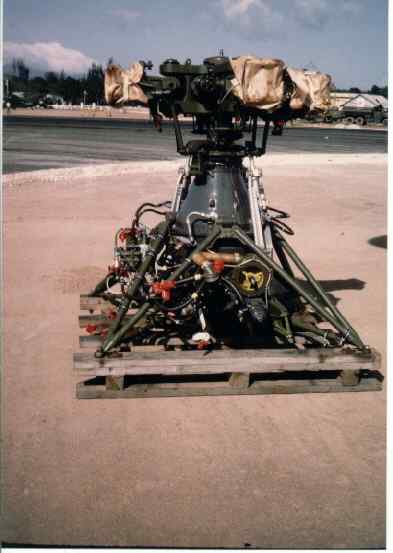
|
The Marine in the foreground that has his hands in
his pockets is PFC. James R. Bubonics and
the guy right in front of him working on the hydraulic struts is PFC.
Michael J. Magan. The guy in the camo flight suit is GySgt.
Robert D. Shane.
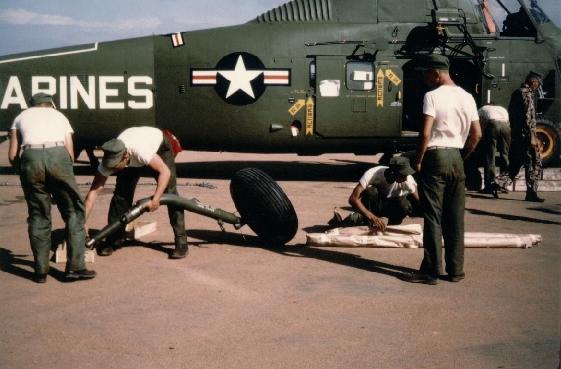
|
We were always glad to see the C-124 on the runway with all the spare parts laying around. For when all the parts were put together some lucky flight crew had a brand new UH-34D. The rest of us had to suffer with our patched up veterans.
Album Index or Home